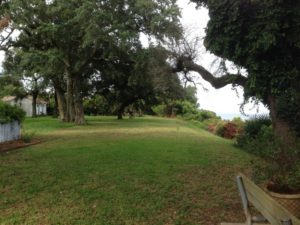After hearing from a fairly evenly split gallery full of neighbors, the Pensacola City Council gave their unequivocal answer: half of the last real remaining open space along the bluffs in the East Pensacola Heights Neighborhood, the right of way along a short defunct stretch of Bay Boulevard, will be given to private property owners.
The council voted unanimously to vacate the property. Mayor Ashton Hayward had laid it out pretty plainly at the discussion’s onset.
“It’s real simple, we don’t need the right of way, the city doesn’t need the right of way,†Hayward said. “There’s not a park there.â€
Though not an official city park, the property — a strip of land about 300 feet by 60 feet— is used by the public. The city doesn’t maintain it, but it did install a bench overlooking the bay. The portion of the strip fronting the property belonging to two couples — the Austins and Picas — falls beyond the bench overlook, which will remain open to public access.
Since learning of the request to vacate, some residents in the neighborhood have actively pushed for council to reject the request. They contend that the vacation is handing over currently used public property that affords the entire neighborhood access to bluff-and-bay views.
“I don’t understand how the city can give away public land to private citizens just because they want it,†said Kevin Smith, who lives three blocks from the site and said he takes daily trips there with his son.
“Three percent, that’s all that’s left,†Harriet Allen pointed out the rest of the right away along the bluffs was already privatized. “You say the city doesn’t wan’t it? How can you say that? We’re the city. We’re begging you. Please don’t vacate the right of way.â€
Other people, however, spoke in support of the request. They cited concerns about future zoning potentials on nearby parcels and safety concerns of inviting the public to the bluffs — “a young man hung himself down there†— as well as the possibilities that, if left as is, the new property owners may well have to cut down trees and wildlife habitat and upend even the park-bench area in order to have the city create an access road.
“This is not a park,†said neighborhood resident Pat Selkirk, “but it is in someone’s back yard.â€
Paul Austin informed the city council that he had cancer and wanted to limit public access for safety reasons.
“Security and safety is my primary concern,†Austin said. “In my absence I want my wife to feel safe and secure.â€
The argument to vacate wasn’t a particularly tough sell to council. They leaned on the fact that half the publicly accessible area, the 150 foot portion with the park bench, would remain open and listed off their rationales for supporting the request.
“I’m not a big proponent of government hanging onto land just to hang on to it,†said Councilman Charles Bare.
“We have to protect the pollinators. You may think I’m going way off hill,†said Councilwoman Sherri Myers, referring to the area’s bee population. “I’m going to vote — against my desire — to vote to vacate this … this property, these bluffs, will be in good hands … the these bees, these bees are safe.â€
Critics of the vacation request were also taken to task. Councilman Larry B. Johnson relayed how he grew up in the area, and it saddened him to see a portion of the neighborhood not being more welcoming the Austins and Picas.
“It really hurts me. It breaks my heart, actually,†Johnson told them.
Mayor Hayward had also noted the need for a different perspective. He talked about the good fortune of having new property owners moving into the city, having them pay taxes and build houses.
The mayor called it a “fabulous story.â€
“This is a story we really need to talk about,†Hayward said.
The slipping away of the right of way, the loss of public access to half the strip of the last land overlooking the bluffs and bay was part of this story. Or, as Robert Beasley, a local attorney representing the property owners at the council meeting, framed it, a case of evolution.
The attorney explained how long-ago streets were laid out by placing grids over maps, resulting in cattywampus nonsense like roads running under water. Bay Boulevard, he said, was little more than an accidental road with a fondness for dipping into the bay, and needed to be “cleaned up†now just as the rest of the right of way portions had been “cleaned up†previous.
“It’s cleaned up over time,†Beasley told the council. “And it’s cleaned up over time with vacations.â€




